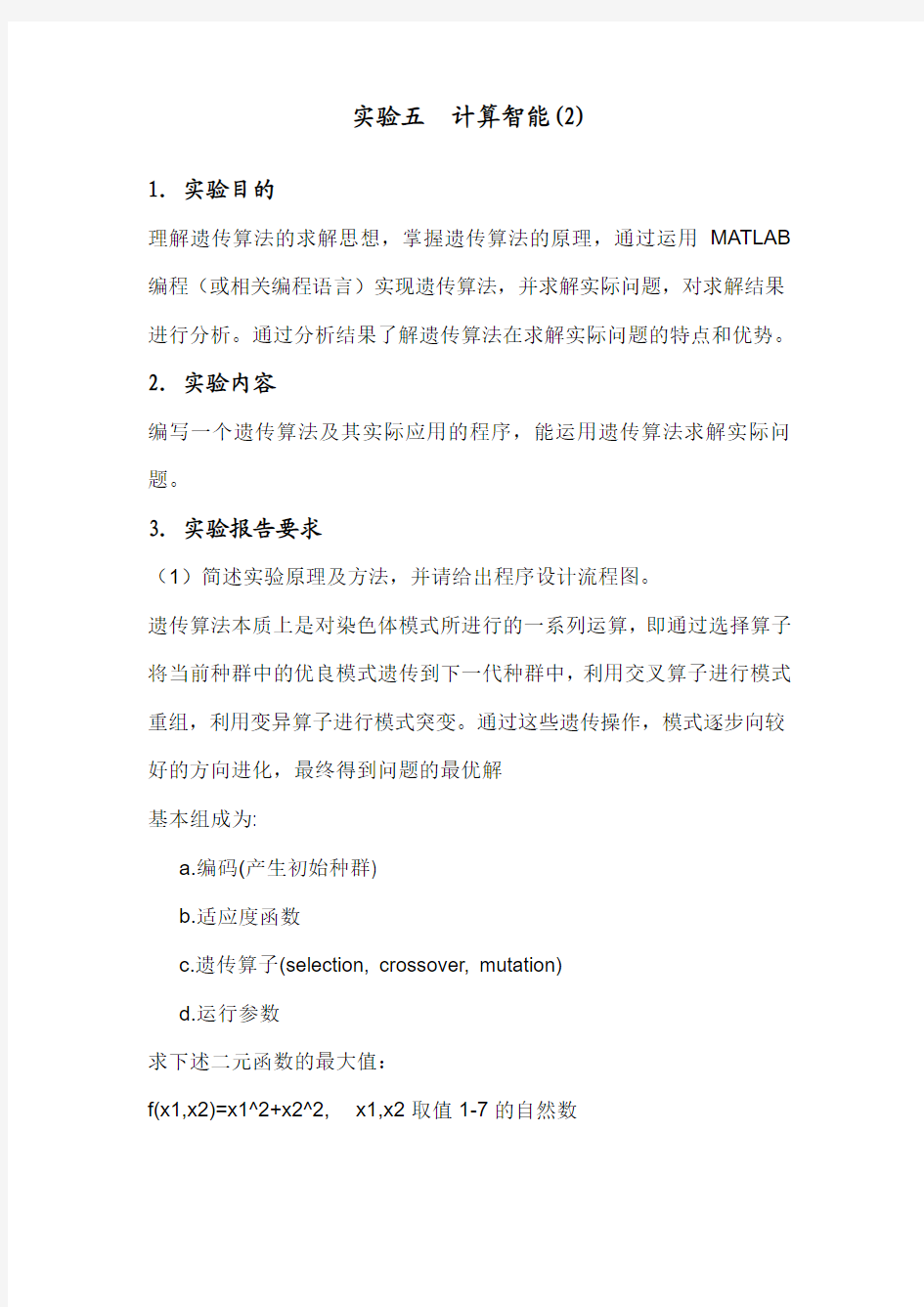遗传算法实验报告


实验五计算智能(2)
1.实验目的
理解遗传算法的求解思想,掌握遗传算法的原理,通过运用MATLAB 编程(或相关编程语言)实现遗传算法,并求解实际问题,对求解结果进行分析。通过分析结果了解遗传算法在求解实际问题的特点和优势。2.实验内容
编写一个遗传算法及其实际应用的程序,能运用遗传算法求解实际问题。
3.实验报告要求
(1)简述实验原理及方法,并请给出程序设计流程图。
遗传算法本质上是对染色体模式所进行的一系列运算,即通过选择算子将当前种群中的优良模式遗传到下一代种群中,利用交叉算子进行模式重组,利用变异算子进行模式突变。通过这些遗传操作,模式逐步向较好的方向进化,最终得到问题的最优解
基本组成为:
a.编码(产生初始种群)
b.适应度函数
c.遗传算子(selection, crossover, mutation)
d.运行参数
求下述二元函数的最大值:
f(x1,x2)=x1^2+x2^2, x1,x2取值1-7的自然数
(2)源程序清单:
#include
#include
#include
/////////////The definiton of user data////
#define Cmax 100 //certain maximal value
#define Cmin 0 //certain minimum value
#define LENGHT1 3 //the chromosome length of 1st variable #define LENGHT2 3 //the chromosome length of 2nd variable
//总染体长度
#define CHROMLENGTH LENGHT1+LENGHT2
const int MaxGeneration = 100; //最大代数
const int PopSize = 10; //样本大小
const double Pc = 0.6; //交叉概率
const double Pm = 0.001; //变异概率
////////////// 数据结构定义/////////////////// struct Individual{
char chrom[CHROMLENGTH + 1]; //一个个体的染色体 double value; //目标值
double fitness; //适应度
};
int generation ; //进化次数
int bestIndex; //最好个体的下标
int worstIndex; //最坏个体的游标
Individual bestIndividual ; //当前一代中的最好个体Individual worstIndividual ; ///当前一代中的坏个体// best individual by now
Individual currentBest ;// 到目前为止的最好个体Individual population [PopSize] ;//样本
///////////////////////
void generateInitialPopulation();
void generateNextPopulation();
void evalutePopulation();
long decomdeChromosome(char*, int, int);
void calculateObjectValue();
void calculateFitnessValue();
void findBestAndWorstIndividual();
void performEvolution();
void selectionOperator();
void crossoverOperator();
void mutationOperator();
void outputTextReport();
//////////////////////////////////////////////
int main(){
generation = 0;
generateInitialPopulation();
evalutePopulation();
while (generation < MaxGeneration) {
generation++;
generateNextPopulation();
evalutePopulation();
performEvolution();
outputTextReport();
}
return 0;
}
//////////////////////////////////////////////////////////////
//////产生第一代样本/////
void generateInitialPopulation() {
int i, j;
srand((unsigned)time(NULL));
for (i = 0; i < PopSize; i++) {
for (j = 0; j < CHROMLENGTH; j++) {
population[i].chrom[j] = ((rand() % 10) < 5) ? '0' : '1'; }
population[i].chrom[CHROMLENGTH] = '/0';
}
}
////////产生下一代样本 //////
void generateNextPopulation() {
selectionOperator();
crossoverOperator();
mutationOperator();
}
//变异算子//
void mutationOperator() {
int i, j;
double p;
// bit mutation
for (i = 0; i < PopSize; i++) {
for (j = 0; j < CHROMLENGTH; j++) {
p = rand() % 1000 / 1000.0;
if (p < Pm) {
population[i].chrom[j] = (population[i].chrom[j] == '0') ? '1': '0';
}
}
}
}
//交叉算子///
void crossoverOperator() {
int i, j;
int index[PopSize];
int point, temp;
double p;
char ch;
for (i = 0; i < PopSize; i++) {
index[i] = i;
}
for (i = 0; i < PopSize; i++) {
point = rand() %(PopSize - i);
temp = index[i];
index[i] = index[point + i];
index[point + i] = temp;
}
for (i = 0; i < PopSize - 1; i+=2) {
p = rand() % 1000 / 1000.0;
if (p < Pc) {
point = rand()% (CHROMLENGTH - 1) + 1;
for (j = point; j < CHROMLENGTH; j++) {
ch = population[index[i]].chrom[j];
population[index[i]].chrom[j] = population[index[i + 1]].chrom[j];
population[index[i + 1]].chrom[j] = ch;
}
}
}
}
///选择算子/////////////
void selectionOperator() {
int i, index;
double p, sum = 0.0;
double cfitness[PopSize];
Individual newpopulation[PopSize];
for (i = 0; i < PopSize; i++) {
sum += population[i].fitness;
}
for (i = 0; i < PopSize; i++) {
cfitness[i] = population[i].fitness / sum;
}
// calculate cumulative fitness
for (i = 1; i < PopSize; i++) {
cfitness[i] = cfitness[i] + cfitness[i - 1];
}
for (i = 0; i < PopSize; i++) {
p = rand() % 1000 / 1000.0;
index = 0;
while (p > cfitness[index]) {
index++;
}
newpopulation[i] = population[index];
}
for (i = 0; i < PopSize; i++) {
population[i] = newpopulation[i];
}
}
/////依据某些公式对样本进行评价////
void evalutePopulation() {
calculateObjectValue();
calculateFitnessValue();
findBestAndWorstIndividual();
}
//找出到目前为止最好的个体//////
void findBestAndWorstIndividual() {
int i;
double sum = 0.0;
bestIndividual = population[0];
worstIndividual = population[0];
for (i = 0; i < PopSize; i++) {
if (population[i].fitness > bestIndividual.fitness) {
bestIndividual = population[i];
bestIndex = i;
} else if (population[i].fitness < worstIndividual.fitness) { worstIndividual = population[i];
worstIndex = i;
}
sum += population[i].fitness;
}
if (generation == 0) {
currentBest = bestIndividual;
} else {
if (bestIndividual.fitness > currentBest.fitness) {
currentBest = bestIndividual;
}
}
}
//计算适应度///
void calculateFitnessValue() {
int i;
long temp1, temp2;
double x1, x2;
for (i = 0; i < PopSize; i++) {
temp1 = decomdeChromosome(population[i].chrom, 0, LENGHT1); temp2 = decomdeChromosome(population[i].chrom, LENGHT1, LENGHT2);
x1 = temp1 * temp1;
x2 = temp2 * temp2;
population[i].fitness = x1+x2;
}
}
//计算目标值
//目标函数为f(x) = x1* x1 + x2*x2
void calculateObjectValue() {
int i;
long temp1, temp2;
double x1, x2;
for (i = 0; i < PopSize; i++) {
temp1 = decomdeChromosome(population[i].chrom, 0, LENGHT1); temp2 = decomdeChromosome(population[i].chrom, LENGHT1, LENGHT2);
x1 = temp1 * temp1;
x2 = temp2 * temp2;
population[i].value = x1 + x2;
}
}
//把二进制转化为十进制
long decomdeChromosome(char* string, int point, int length) {
int i;
long decimal = 0L;
char * pointer;
for(i = 0, pointer=string+point; i < length;i++,pointer++){
decimal += (*pointer - '0') << (length - 1 - i);
}
return decimal;
}
//进经同时把最坏个体用目前最好个人替代///
void performEvolution() {
if (bestIndividual.fitness > currentBest.fitness) {
currentBest = population[bestIndex];
} else {
population[worstIndex] = currentBest;
}
}
//打印当前样本信息///
void outputTextReport() {
int i;
double sum;
double average;
sum = 0.0;
for (i = 0; i < PopSize; i++) {
sum += population[i].value;
}
average = sum / PopSize;
printf("gen=%d, avg=%f, best=%f",generation, average,currentBest.value);
printf(" chromosome=");
for( i = 0; i < CHROMLENGTH; i++){
printf("%c", currentBest.chrom[i]);
}
printf("/n");
}
(3)实验结果及分析。
从结果可以看出,遗传算法收敛得非常快,在第5代的时候,已经达到了全局最优解.如果把初始种群扩大,收敛得会更快.实验很好的完成了实验任务,数值方法求解这一问题的主要手段是迭代运算。一般的迭代方法容易陷入局部极小的陷阱而出现"死循环"现象,使迭代无法进行。遗传算法很好地克服了这个缺点,是一种全局优化算法。
